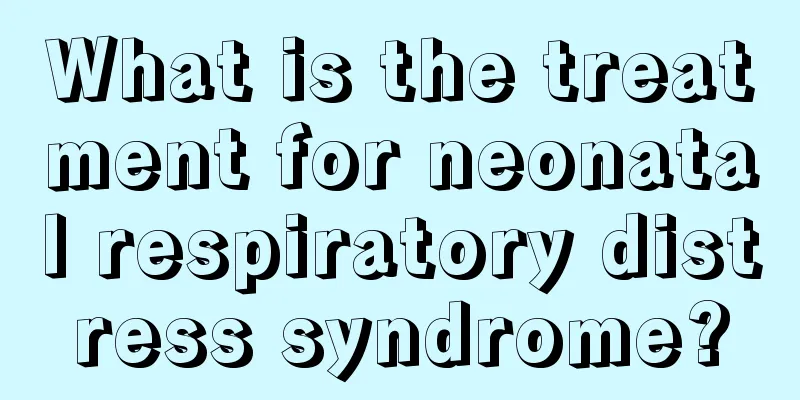What is the treatment for neonatal respiratory distress syndrome?

|
A newborn is a new life that has just been born. Since a newborn baby is not adapted to the external environment, this will cause many symptoms. In such an environment, it is necessary to observe the baby carefully, because the vital signs of the newborn are unstable, so better observation and treatment are needed. The following are the treatment methods for neonatal respiratory distress syndrome. The European Guidelines for the Prevention and Treatment of Neonatal Respiratory Distress Syndrome (2010) point out that a single course of antenatal hormone therapy has a preventive effect on neonatal respiratory distress syndrome, but the potential benefits and long-term safety of repeated hormone administration remain unclear; many clinical treatments for stable premature infants at birth have no evidence-based medical evidence, including the use of oxygen and active positive pressure ventilation, which may sometimes even be harmful to the infant; surfactant replacement therapy is crucial in the management of neonatal respiratory distress syndrome, but the optimal formulation, optimal dose and optimal use time for premature infants of different gestational ages are still unclear; mechanical ventilation, a form of respiratory support, can save the life of the infant, but it can easily cause lung damage, and the treatment strategy should use nasal continuous positive airway pressure or nasal ventilation as much as possible, and avoid mechanical ventilation as much as possible; in order to achieve the best prognosis for infants with neonatal respiratory distress syndrome, good supportive treatment must be given, including maintaining normal body temperature, appropriate fluid therapy, good nutritional support, handling of ductus arteriosus patency, and circulatory support to maintain proper tissue perfusion. 1. Nursing Care should be strengthened as for premature infants. Place the baby in an incubator at moderate temperature or on a radiant infrared warming bed, and use a monitor to monitor body temperature, respiration, heart rate, and transcutaneous measurement of TcO2 and TcCO2. Also monitor mean airway pressure. The ambient temperature needs to maintain the abdominal skin temperature at 36.5°C or the rectal temperature (core or deep temperature) at 37°C to keep the body's oxygen consumption at the lowest level. The relative humidity should be around 50%. Clear pharyngeal mucus regularly to keep the airways open. Pay attention to the amount of fluid intake and nutrition. Intravenous high-nutrient solution drip can be used, and breastfeeding can be performed until the baby is able to suck and swallow. 2. Oxygen supply and mechanical respiration To improve hypoxia and reduce anaerobic metabolism, sufficient oxygen must be supplied. For mild cases, nasal congestion, mask or continuous positive airway pressure (CPAP) can be used. If FiO2 has reached 0.8, but PaO2 is still below 6.65kP (50mmHg), tracheal intubation and use of a ventilator are required. The peak inspiratory pressure does not exceed 2.9 kPa (30 cmH2O), the mean airway pressure is less than 0.98 kPa (less than 10 cmH2O), the respiratory rate is 25 to 30 times/min, and the inspiratory time (I): (E) = 1:1 to 2. FiO2 is high at the beginning and then gradually decreases to 0.4. When removing the ventilator, first transition to enhanced breathing (IMV), with one enhancement every 10 breaths. High-frequency breathing can also be used, with smaller tidal volume and higher ventilation frequency for ventilation. Due to some reason, the inhalation time is short, so the peak inspiratory pressure and mean airway pressure are low, and the intrathoracic pressure is also low, which is conducive to venous return. The commonly used method is high-frequency jet ventilation (HFJV). A nasal cannula is inserted into the nasal cavity of the newborn about 1.5 to 2 cm, driving the oxygen pressure (working pressure) of 0.125 kg/cm2, and the jet frequency of 150 to 300 times/min. After 1 to 3 hours depending on the condition, it is alternately treated with general nasal congestion method for oxygen supply until the blood PaO2 can be maintained above 7.98 kPa (60 mmHg), but not more than 11.97 to 13.3 kPa (90 to 100 mmHg), then the nasal congestion method can be used instead. The above is the treatment method for neonatal respiratory distress syndrome. I hope it will attract attention and get more attention. The vital signs of newborns are unstable. In such an environment, it is very good to observe and treat them well. Because they are not familiar with the external environment, the symptoms caused are also different, so they should be treated well. |
<<: What to do if your baby is breathing heavily
>>: What to do if your newborn is breathing heavily
Recommend
What to do if your newborn has dry mouth
Newborns have a relatively weak constitution. In ...
What medicine should children take for bedwetting at night
Bedwetting is a normal thing for many people, but...
Infant head hematoma causes jaundice
Many newborns are particularly prone to jaundice ...
What is the best way to treat body odor in children?
Everyone is very afraid of body odor. Although bo...
Neonatal jaundice MRI
The main symptom of neonatal jaundice is the yell...
What are the main symptoms of neonatal cerebral palsy?
The birth of a baby represents new hope and is so...
What to do if your baby has a blocked nose while sleeping
When taking care of their babies, many parents fi...
What should I do if my child suddenly has a fever in the middle of the night?
Babies are prone to fever in summer. Because the ...
Five-year-old child sweats while sleeping
When children have night sweats, the first thing ...
What should I do if my child suddenly has a fever and convulsions?
Every parent needs to be responsible for the heal...
What should babies with weak spleen and stomach eat?
The baby's body is relatively delicate. If th...
What to do if your five-year-old baby is zinc deficient
The healthy physical development of children is w...
What is the cause of vulvitis in girls
Children's health and hygiene are of concern ...
Parenting knowledge for children aged 0 to 6 months
How to raise a newborn baby? This is a topic that...
What to do and what to pay attention to when checking your baby's heart
The physical health of many newborn babies is not...









